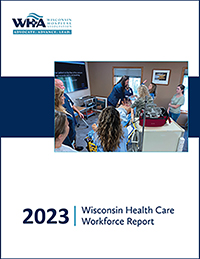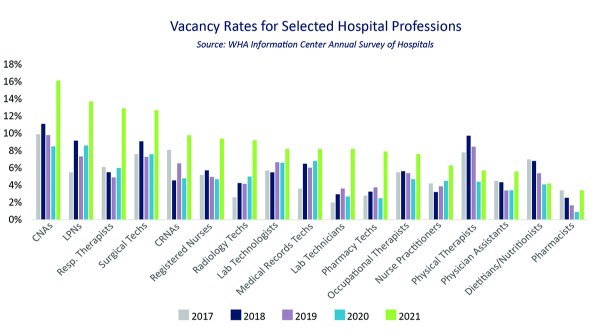Vol. 67, Issue 13
View more issues of The Valued Voice
Sign Up for WHA's Newsletter
Click here to view past issues
IN THIS ISSUE
- WHA 2023 Workforce Report: Wisconsin’s Health Care Workforce Falling Further Behind Demand for Care
- Bulk Claim Denials by Insurer Leads to Higher Costs for Patients
- New Analysis of Physician-Owned Hospitals Highlights Cherry-Picking Lucrative Patients While Delivering Lower Quality Care
- Skewed Claims About Hospital Price Transparency Debunked at E&C Hearing
- New AHA Report Highlights Value of Hospital Outpatient Departments and Danger of "Site-Neutral" Payments
- Joint Legislative Council Committee Votes to Approve Study Committee Recommendations
- Registration Open for 2023 Wisconsin Rural Health Conference
- WHA Workforce Well-Being Survey – Responses from Valued WHA Hospital Leaders Highly Encouraged
- WHA Foundation Announces Application Open for 2023 Clinical Simulation Lab Scholarship
- Share Your Hospital's Quality Improvement Stories
EDUCATION EVENTS
Dec. 16, 2025
Common Hospital DeficienciesJan. 14, 2026
Caring for Wisconsin’s Caregivers Well-Being First Champion Challenge for Credentialing KickoffJan. 28, 2026
2026 WHA Health Care Leadership AcademyClick here to view education event calendar
View more issues of The Valued Voice
Sign Up for WHA's Newsletter
Thursday, March 30, 2023
 On March 28, WHA released its 2023 Health Care Workforce Report, which highlights data trends and analysis of Wisconsin’s health care workforce. According to this year’s report, as Wisconsin’s aging population continued to depart the workforce, high job vacancy rates persisted as demand for care grew in 2022 putting further strain on the health care workforce to grow at a fast rate.
On March 28, WHA released its 2023 Health Care Workforce Report, which highlights data trends and analysis of Wisconsin’s health care workforce. According to this year’s report, as Wisconsin’s aging population continued to depart the workforce, high job vacancy rates persisted as demand for care grew in 2022 putting further strain on the health care workforce to grow at a fast rate.
“Wisconsin hospitals are working hard to grow, recruit, retain and support the health care workforce necessary to sustain the high-quality health care Wisconsin citizens expect and deserve,” said WHA Senior Vice President of Workforce and Clinical Practice Ann Zenk. “But even with concerted effort, it is unlikely that the health care workforce can grow fast enough to meet the rising health care demand of an aging population.”

The report underscores the dual impact on health care of the aging, very large baby boom generation–the so-called “Silver Tsunami.” By 2030, one in five Americans will be at retirement age. In Wisconsin, it’s closer to one in four. The surge in retirements is a demographic force impacting all industries. Health care faces an additional challenge because health care needs grow as individuals age. Those over the age of 65 make up 20% of the population but account for more than 40% of health care utilization. Conversely, those younger than 35 make up more than 40% of the population, but account for less than 20% of health care demand. The last of the baby boom generation turns 65 in 2032, and while the surge of retirements will subside for other industries, the Silver Tsunami’s impact on health care demand and the health care workforce will persist for decades to come.
This is WHA’s 19th annual analysis of the current and future state of Wisconsin’s health care workforce. The annual report also addresses the urgent and sustainable action needed to support health care teams striving to meet rising demand with a shrinking population. WHA asks policymakers, educators and health care stakeholders to continue to partner to leverage teams, technology and top-of-training practice to increase capacity with a workforce that cannot grow fast enough.
WHA’s report highlights the important work being done by hospitals and health systems to not only support workplace well-being, but also meet the expectations of a workforce that now includes five generations. The report also points to the lessons learned over the course of the last three years to reduce regulatory burdens that are a major cause of burnout and inefficiency for the health care workforce.
“The past three years have provided the opportunity to rapidly pilot waivers and regulatory flexibilities and see that they’ve worked – it’s okay,” said WHA President and CEO Eric Borgerding. “We need to take the knowledge we’ve gained to make permanent improvements.”
Finally, the report cautions, with the many challenges on the table at the same time for hospitals and the health care workforce, Wisconsin’s health care, long-term care and public health infrastructure must support communities getting the right care, in the right place, at the right time. A hospital’s doors are always open, and Wisconsin’s health care workforce is proud to provide top-quality care for Wisconsin. As the safety net for their communities, hospitals and health systems have become stretched increasingly thin. It has become clear that hospitals cannot continue to assume the health care, long-term care and public health mantle for the state on an ongoing basis without additional resources and support.
Good health care policy supports high-quality health care. Wisconsin’s perennial top-ranking health care quality demonstrates the achievements already made, and that must continue to be made together by health care organization leaders, and trustees, health care professionals, educators, policymakers, community leaders and other key stakeholders.
Read the 2023 Wisconsin Health Care Workforce Report here.
WHA 2023 Workforce Report: Wisconsin’s Health Care Workforce Falling Further Behind Demand for Care
An aging population compounds workforce challenges and exacerbates the need to grow the health care workforce at a faster rate
 On March 28, WHA released its 2023 Health Care Workforce Report, which highlights data trends and analysis of Wisconsin’s health care workforce. According to this year’s report, as Wisconsin’s aging population continued to depart the workforce, high job vacancy rates persisted as demand for care grew in 2022 putting further strain on the health care workforce to grow at a fast rate.
On March 28, WHA released its 2023 Health Care Workforce Report, which highlights data trends and analysis of Wisconsin’s health care workforce. According to this year’s report, as Wisconsin’s aging population continued to depart the workforce, high job vacancy rates persisted as demand for care grew in 2022 putting further strain on the health care workforce to grow at a fast rate.“Wisconsin hospitals are working hard to grow, recruit, retain and support the health care workforce necessary to sustain the high-quality health care Wisconsin citizens expect and deserve,” said WHA Senior Vice President of Workforce and Clinical Practice Ann Zenk. “But even with concerted effort, it is unlikely that the health care workforce can grow fast enough to meet the rising health care demand of an aging population.”

The report underscores the dual impact on health care of the aging, very large baby boom generation–the so-called “Silver Tsunami.” By 2030, one in five Americans will be at retirement age. In Wisconsin, it’s closer to one in four. The surge in retirements is a demographic force impacting all industries. Health care faces an additional challenge because health care needs grow as individuals age. Those over the age of 65 make up 20% of the population but account for more than 40% of health care utilization. Conversely, those younger than 35 make up more than 40% of the population, but account for less than 20% of health care demand. The last of the baby boom generation turns 65 in 2032, and while the surge of retirements will subside for other industries, the Silver Tsunami’s impact on health care demand and the health care workforce will persist for decades to come.
This is WHA’s 19th annual analysis of the current and future state of Wisconsin’s health care workforce. The annual report also addresses the urgent and sustainable action needed to support health care teams striving to meet rising demand with a shrinking population. WHA asks policymakers, educators and health care stakeholders to continue to partner to leverage teams, technology and top-of-training practice to increase capacity with a workforce that cannot grow fast enough.
WHA’s report highlights the important work being done by hospitals and health systems to not only support workplace well-being, but also meet the expectations of a workforce that now includes five generations. The report also points to the lessons learned over the course of the last three years to reduce regulatory burdens that are a major cause of burnout and inefficiency for the health care workforce.
“The past three years have provided the opportunity to rapidly pilot waivers and regulatory flexibilities and see that they’ve worked – it’s okay,” said WHA President and CEO Eric Borgerding. “We need to take the knowledge we’ve gained to make permanent improvements.”
Finally, the report cautions, with the many challenges on the table at the same time for hospitals and the health care workforce, Wisconsin’s health care, long-term care and public health infrastructure must support communities getting the right care, in the right place, at the right time. A hospital’s doors are always open, and Wisconsin’s health care workforce is proud to provide top-quality care for Wisconsin. As the safety net for their communities, hospitals and health systems have become stretched increasingly thin. It has become clear that hospitals cannot continue to assume the health care, long-term care and public health mantle for the state on an ongoing basis without additional resources and support.
Good health care policy supports high-quality health care. Wisconsin’s perennial top-ranking health care quality demonstrates the achievements already made, and that must continue to be made together by health care organization leaders, and trustees, health care professionals, educators, policymakers, community leaders and other key stakeholders.
Read the 2023 Wisconsin Health Care Workforce Report here.
Vol. 67, Issue 13
Thursday, March 30, 2023
WHA 2023 Workforce Report: Wisconsin’s Health Care Workforce Falling Further Behind Demand for Care
An aging population compounds workforce challenges and exacerbates the need to grow the health care workforce at a faster rate
 On March 28, WHA released its 2023 Health Care Workforce Report, which highlights data trends and analysis of Wisconsin’s health care workforce. According to this year’s report, as Wisconsin’s aging population continued to depart the workforce, high job vacancy rates persisted as demand for care grew in 2022 putting further strain on the health care workforce to grow at a fast rate.
On March 28, WHA released its 2023 Health Care Workforce Report, which highlights data trends and analysis of Wisconsin’s health care workforce. According to this year’s report, as Wisconsin’s aging population continued to depart the workforce, high job vacancy rates persisted as demand for care grew in 2022 putting further strain on the health care workforce to grow at a fast rate.“Wisconsin hospitals are working hard to grow, recruit, retain and support the health care workforce necessary to sustain the high-quality health care Wisconsin citizens expect and deserve,” said WHA Senior Vice President of Workforce and Clinical Practice Ann Zenk. “But even with concerted effort, it is unlikely that the health care workforce can grow fast enough to meet the rising health care demand of an aging population.”

The report underscores the dual impact on health care of the aging, very large baby boom generation–the so-called “Silver Tsunami.” By 2030, one in five Americans will be at retirement age. In Wisconsin, it’s closer to one in four. The surge in retirements is a demographic force impacting all industries. Health care faces an additional challenge because health care needs grow as individuals age. Those over the age of 65 make up 20% of the population but account for more than 40% of health care utilization. Conversely, those younger than 35 make up more than 40% of the population, but account for less than 20% of health care demand. The last of the baby boom generation turns 65 in 2032, and while the surge of retirements will subside for other industries, the Silver Tsunami’s impact on health care demand and the health care workforce will persist for decades to come.
This is WHA’s 19th annual analysis of the current and future state of Wisconsin’s health care workforce. The annual report also addresses the urgent and sustainable action needed to support health care teams striving to meet rising demand with a shrinking population. WHA asks policymakers, educators and health care stakeholders to continue to partner to leverage teams, technology and top-of-training practice to increase capacity with a workforce that cannot grow fast enough.
WHA’s report highlights the important work being done by hospitals and health systems to not only support workplace well-being, but also meet the expectations of a workforce that now includes five generations. The report also points to the lessons learned over the course of the last three years to reduce regulatory burdens that are a major cause of burnout and inefficiency for the health care workforce.
“The past three years have provided the opportunity to rapidly pilot waivers and regulatory flexibilities and see that they’ve worked – it’s okay,” said WHA President and CEO Eric Borgerding. “We need to take the knowledge we’ve gained to make permanent improvements.”
Finally, the report cautions, with the many challenges on the table at the same time for hospitals and the health care workforce, Wisconsin’s health care, long-term care and public health infrastructure must support communities getting the right care, in the right place, at the right time. A hospital’s doors are always open, and Wisconsin’s health care workforce is proud to provide top-quality care for Wisconsin. As the safety net for their communities, hospitals and health systems have become stretched increasingly thin. It has become clear that hospitals cannot continue to assume the health care, long-term care and public health mantle for the state on an ongoing basis without additional resources and support.
Good health care policy supports high-quality health care. Wisconsin’s perennial top-ranking health care quality demonstrates the achievements already made, and that must continue to be made together by health care organization leaders, and trustees, health care professionals, educators, policymakers, community leaders and other key stakeholders.
Read the 2023 Wisconsin Health Care Workforce Report here.
IN THIS ISSUE
- WHA 2023 Workforce Report: Wisconsin’s Health Care Workforce Falling Further Behind Demand for Care
- Bulk Claim Denials by Insurer Leads to Higher Costs for Patients
- New Analysis of Physician-Owned Hospitals Highlights Cherry-Picking Lucrative Patients While Delivering Lower Quality Care
- Skewed Claims About Hospital Price Transparency Debunked at E&C Hearing
- New AHA Report Highlights Value of Hospital Outpatient Departments and Danger of "Site-Neutral" Payments
- Joint Legislative Council Committee Votes to Approve Study Committee Recommendations
- Registration Open for 2023 Wisconsin Rural Health Conference
- WHA Workforce Well-Being Survey – Responses from Valued WHA Hospital Leaders Highly Encouraged
- WHA Foundation Announces Application Open for 2023 Clinical Simulation Lab Scholarship
- Share Your Hospital's Quality Improvement Stories

